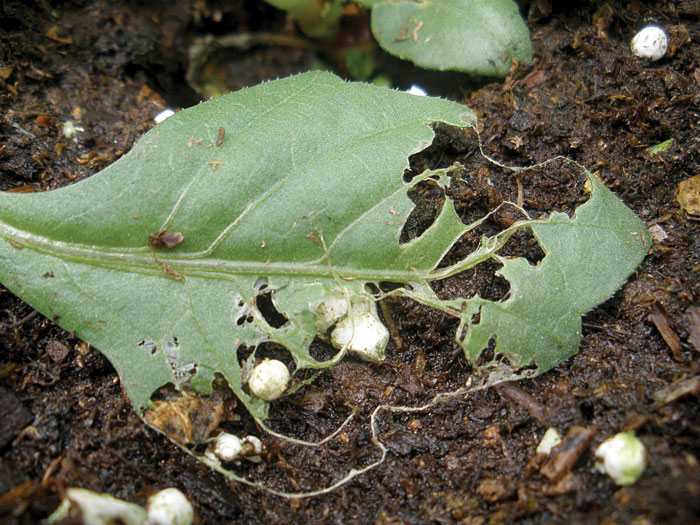10/1/2019
Dinner is Served!
Rick Yates

The rove beetle, known as Atheta coriaria and more recently Dalotia coriaria, says, “Call me whatever you want, just don’t call me late for dinner!” These tiny predator beetles are voracious feeders that use their appetite for soil-borne pests to the benefit of greenhouse growers. Their menu includes the pupal stage of thrips, fungus gnat and shorefly larvae, and other soil-dwelling insects. They also feed on fungus gnat eggs, with adults shown to eat over 100 per day!
They’re nocturnal, so they do most of their work under the cover of darkness. The larval stages are white to yellow or orange, but the adult stages are shiny and dark brown. The adults are quite small—less than 1/8 of an inch in length.
Pictured: Fungus gnat larvae skeletonizing dahlia leaf tissue in contact with the soil.
All life stages of the rove beetles are very mobile, aggressive feeders; the adult stage is winged to aid in disbursement. They use a keen sense of smell to track down their food sources and they’re tolerant of a wide range of temperatures. They’ve been shown to survive down to 39F (3C), but consider the low 50s to be the low end of the effective range. This makes them effective at lower temperatures than the predator mite, Stratiolaelaps (Hypoaspis) miles, that’s often used in concert with rove beetles to control the same pests.
The life cycle is temperature dependent—about 21 days with temperatures around 70F (21C). Some BCAs enter into diapause as the days become shorter and the temperatures cool. Diapause is similar to hibernation, a phase where the insect or mite isn’t active until warmer temperatures return. Rove beetles don’t enter into diapause.
When you tally up the attributes of the small, but mighty, rove beetle, it’s easy to see why they’re good partners in year-round IPM programs. Combined with other biological control agents (BCAs) that feed on other life stages, rove beetles provide an important component in breaking up the life cycle of important pests such as thrips. They can also be valuable components of a conventional pesticide program so long as compatible pesticides are emphasized.
In a moist environment, rove beetles can reproduce successfully on a wide variety of soilless media, such as peat moss, pine bark, rockwool and coir. This allows growers to maintain a high level of rove beetles at a relatively low cost. For years, growers have placed rove beetles in small piles of approximately 25 adult beetles with other life stages present spread sporadically throughout the greenhouse on the floors, and along baseboards where moist soil or algae are present. The high mobility of this predator makes the exact placement of the breeding colonies less important. For concrete floors and other dryer environments, growers can place piles on the surface of soilless media in containers that are kept moist under the benches.
A recent innovation from Bioline Agrosciences has resulted in a breeding station to further automate production of large quantities of rove beetles, improving reliability while reducing the cost further. They refer to the system as a “breeder bucket.” The system begins with a specifically designed bucket that’s filled with media selected for this purpose. Once the media is uniformly moistened, a 1-liter (500 beetles) tube of the rove beetles is added along with 2 teaspoons of the provided food. This mixture is tumbled within the bucket to ensure good uniformity of the various life stages of rove beetle and the food.
The bucket is placed within the greenhouse out of direct sunlight. There’s a weekly recipe for the amount of water and food that’s added, and the bucket is tumbled each time the additions are made. The rove beetles do the rest! Creative growers have developed their own versions of breeding stations with good success.
Biocontrol specialists and consultants are valuable resources to assist you with creating and maintaining BCA based and blended pest control programs. GT
Rick Yates is GGSPro Technical Support Manager for Griffin. He can be reached at ggsprotech@griffinmail.com.